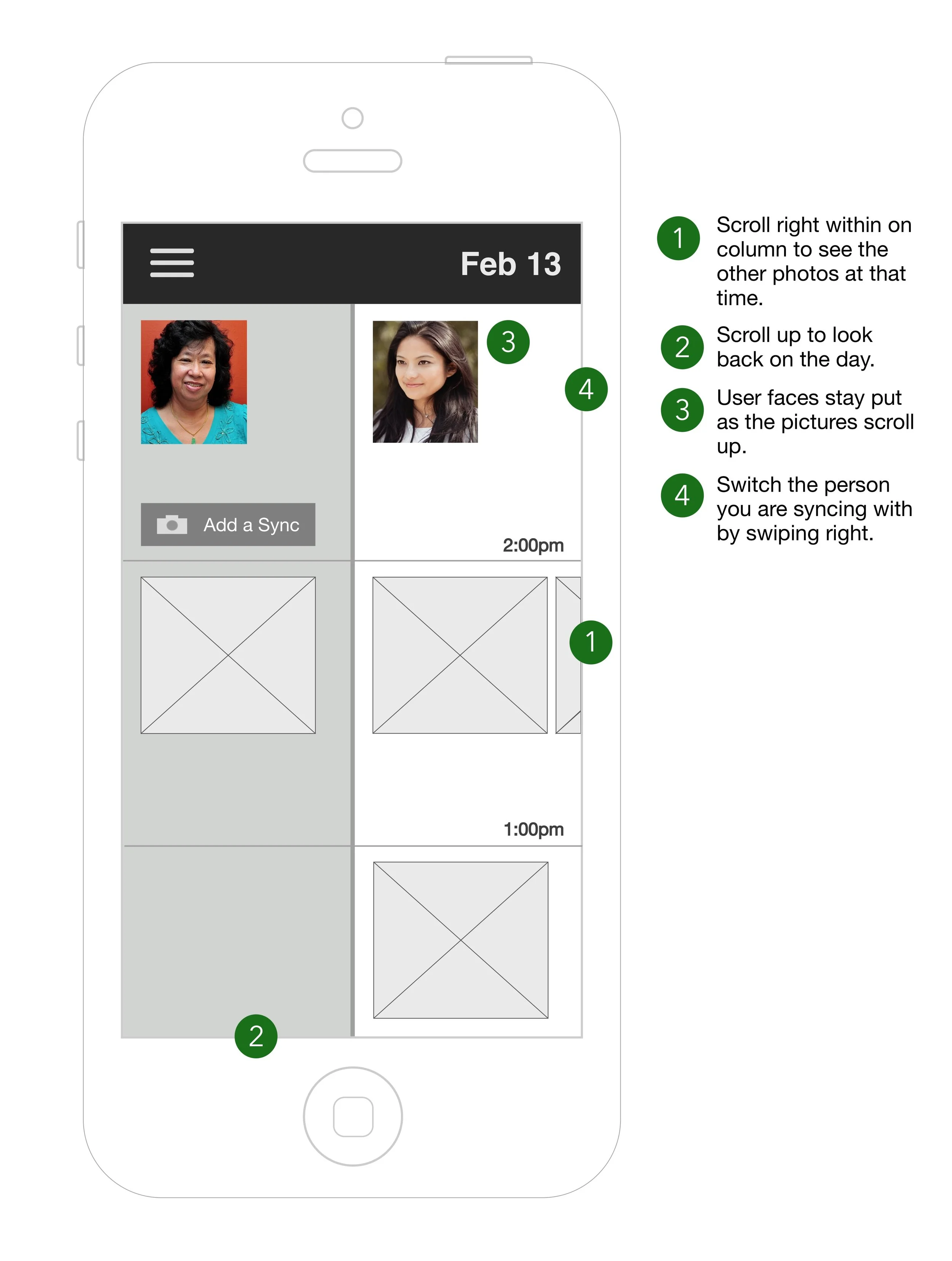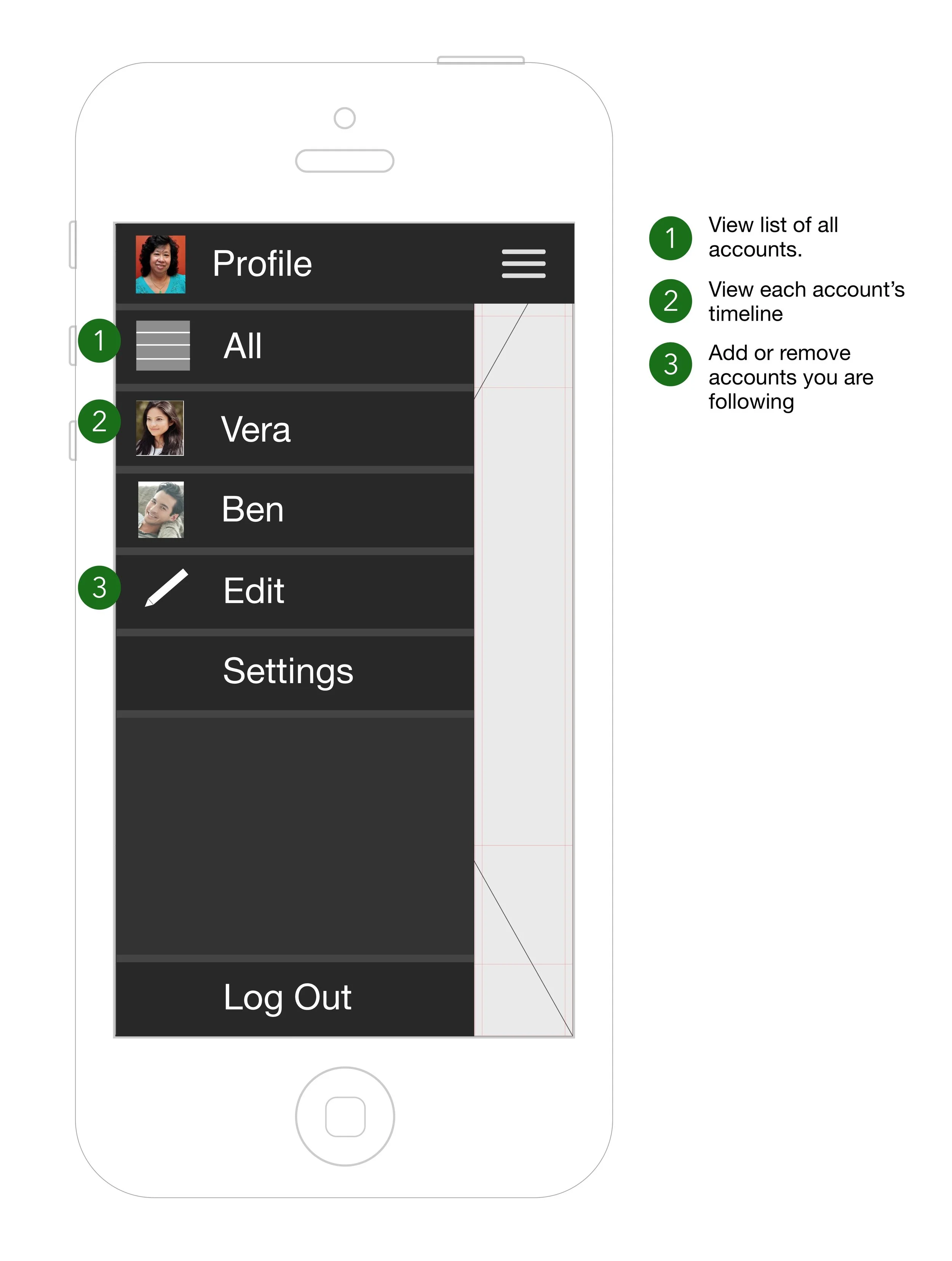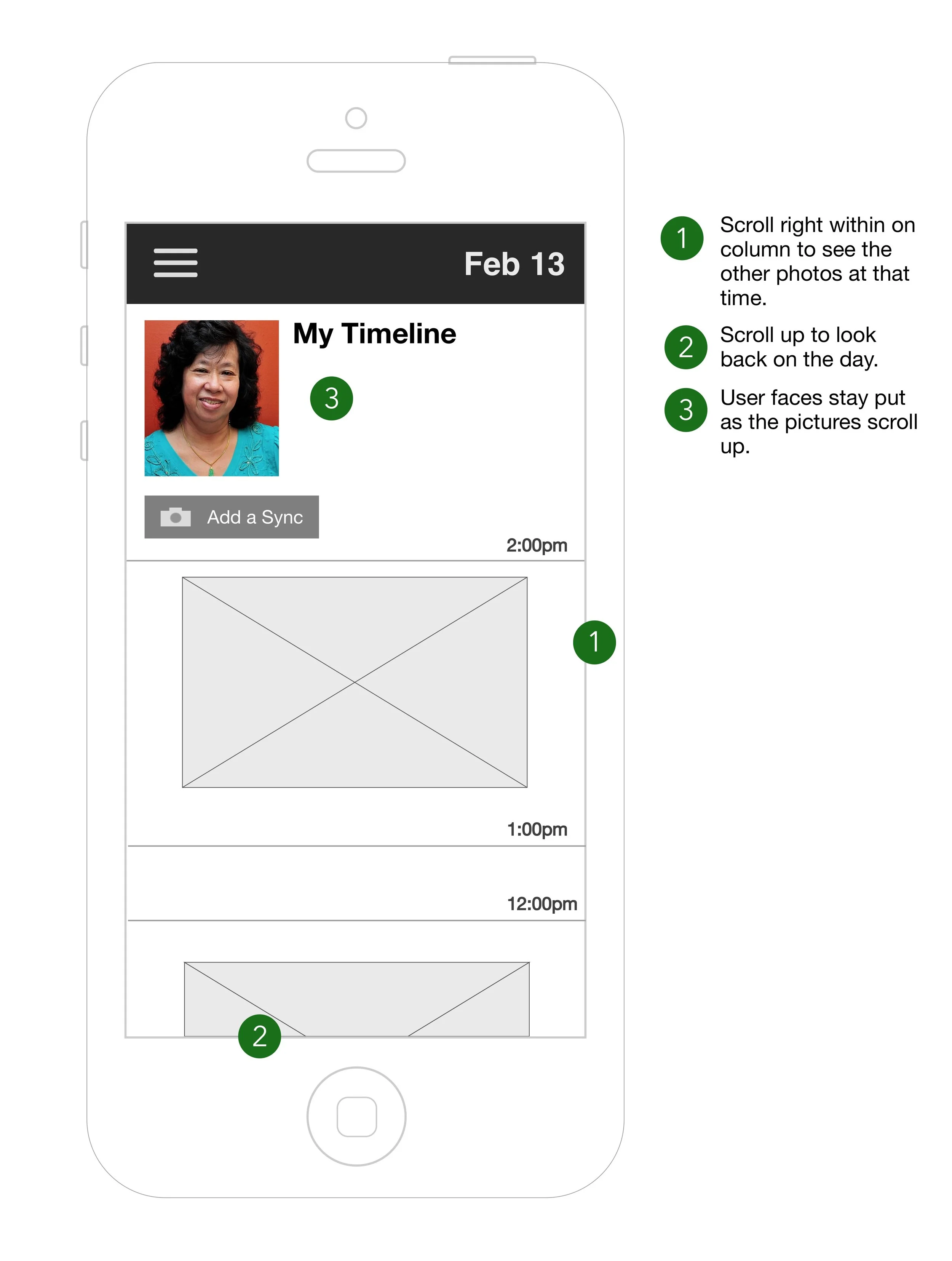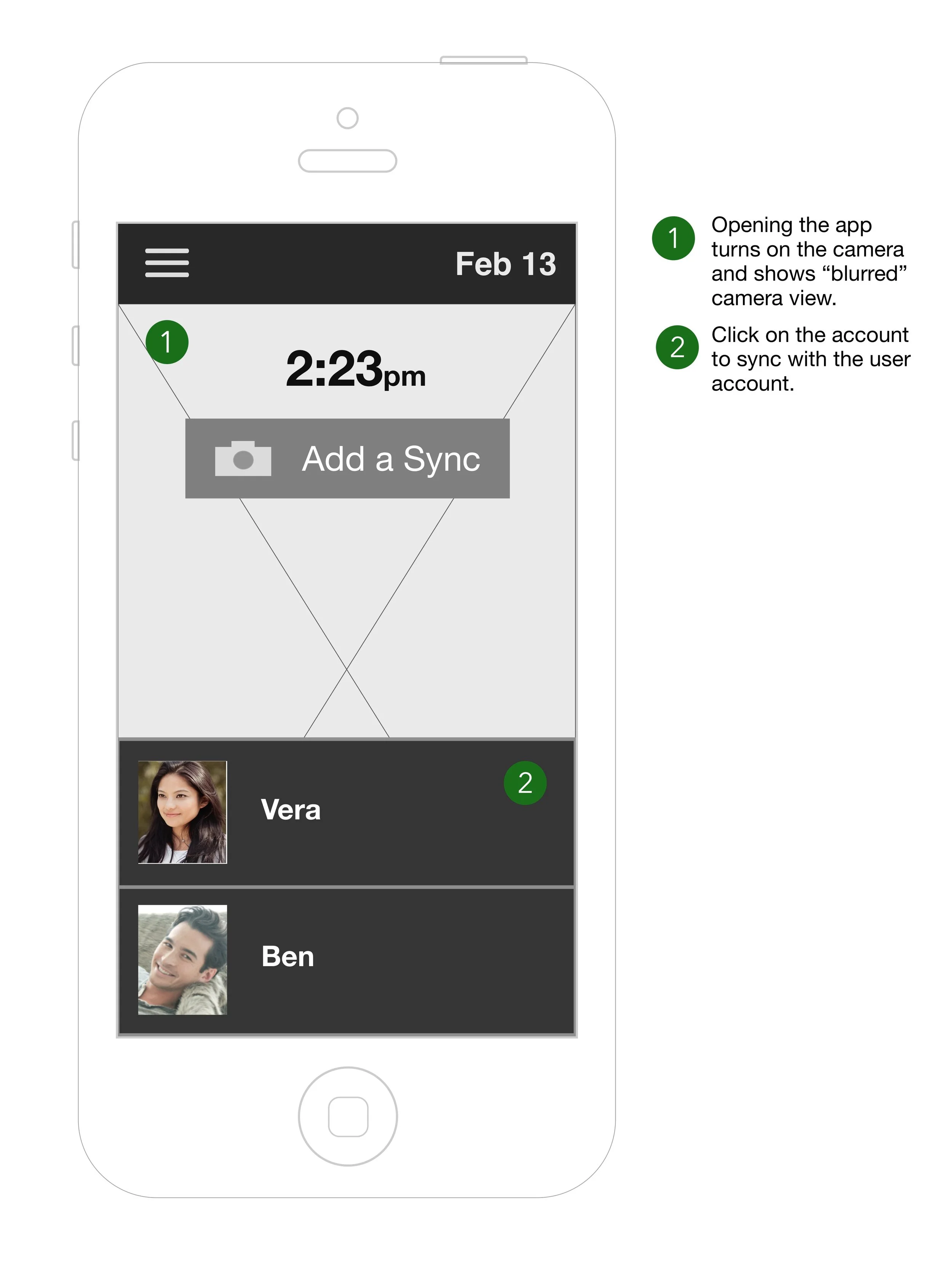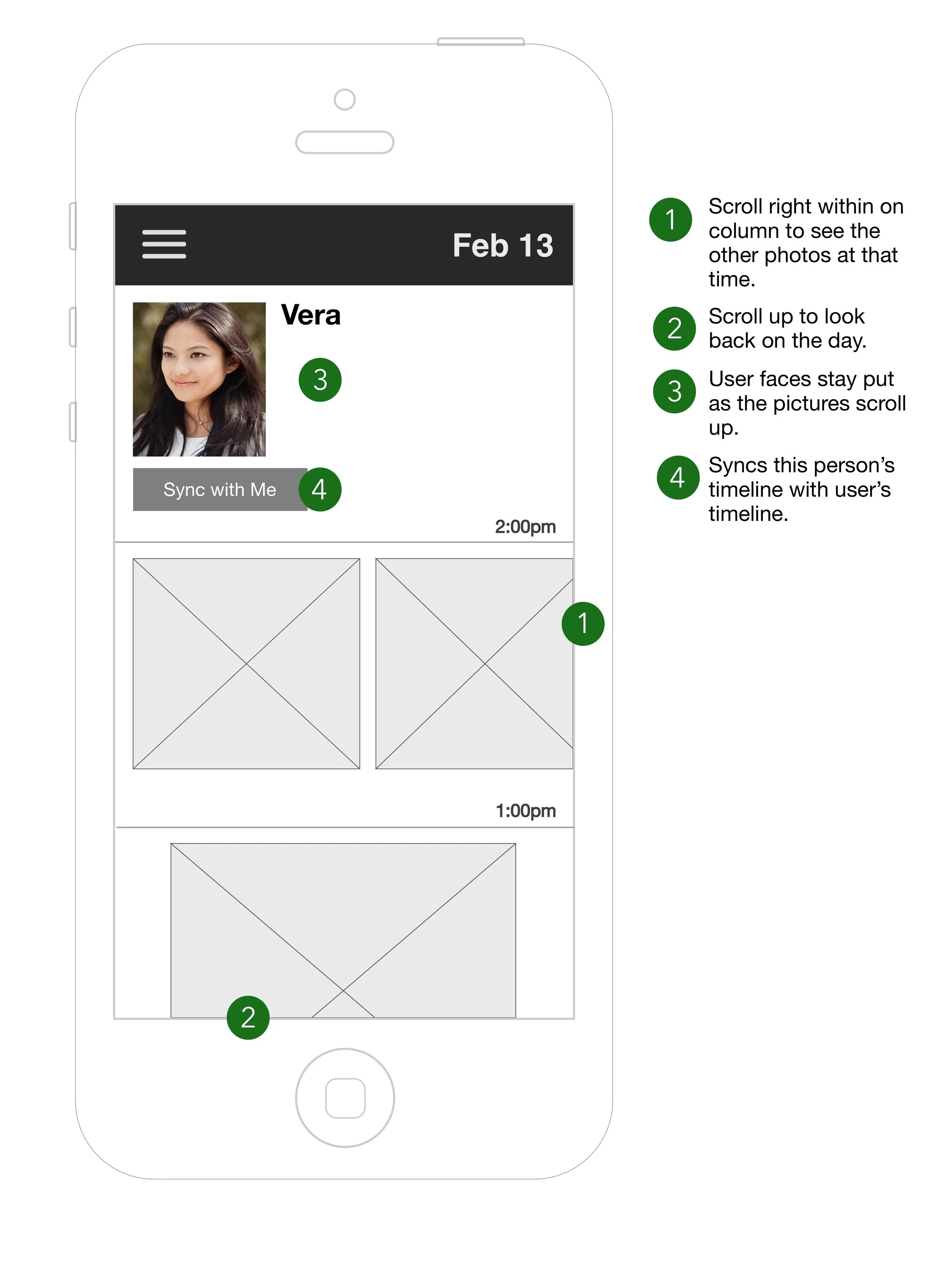SYNC NEW [working edition]
Quick Notes
Background: Adult children and parents who live apart from each other across timezones experience a disconnect.
Objective: Create an app that connects adult children and their parents across timezones.
Role: Designer, User Researcher
Time: 1.5 months
Process:
User Interviews
Personas/Scenarios
Wireframes/Navigational Map
Deliverables:
Wireframes/Navigational Map
Medium Fidelity Prototype
Design Specifications
Sync is an app that connects families across the globe by chronicling and aligning their everyday moments.
Sync connects loved ones across timezones.
Recently, I’ve been reworking my portfolio pieces from interaction design class project . We called it Sync. Here’s what it looked like. Overall, it was interesting, it was novel, it was a design class project.
It was an app where you could see your day in pictures next to another person’s day in pictures (our use case was a mother who had a 12 hour time difference with her daughter). The special sauce of Sync was taking the photos that happened, say at noon on the mother’s side, and putting it with the photos that happened at noon on the daughter’s side. This really only made sense on specific occasions such as holidays.
But recently, I’ve had to describe this project in my portfolio, which made me think about it more, especially with what I’ve learned over the past few years.
Sync is made to help you reflect over your day and the other person’s day. In the case of the mother that is 12 hours ahead of her daughter, she would have to wait 12 hours to compare what she just did to what her daughter just did. Say it’s Chinese New Years, where typically there’s a huge family lunch. The mother misses her daughter who has moved away and can no longer make this annual family occasion. So having just finished lunch, she would have to wait 12 hours to see what her daughter did for Chinese New Year’s lunch. By that time, the mother is probably asleep. It would work out for the daughter, because she’s constantly getting updates of what has already happened. She can already see her mom’s lunch as soon as she eats. However, it wouldn’t work out for her mom.
We made Sync with the purpose of connecting parents with their adult children in a contextual, worry-free, delightful way. However, thinking back to this, this wouldn’t be the result. (This was also a design class project, so as soon as the wireframes were done, the project was done.) The person “behind in time” would always get these delightful updates that aligned their day with another person’s. However the person “ahead of time” would never have the same experience. In fact, it would probably magnify the disconnect they feel from the other person.
So where did I go from here? I knew why it didn’t work, but I couldn’t just get rid of the problem (which was the time difference itself).
Back to the drawing board.
So back to the drawing board I went. I looked at the initial research we did. We interviewed parents who were either in Asia or Europe. We interviewed college aged students that were in the US. The concerns that were brought up were:
- One mom had trouble connecting with her son because he was always busy. For her, it would be great if she could know when he’s available, what his schedule is, and where he is.
- Generally, both the parents and child will text or leave messages because it’s less intrusive.
- A mom mentioned she has to always keep the time in mind when she calls because of the different timezones.
- Conversation topics are generally about the adult child’s children, food, traffic, the weather, what activities they’re engaged in, stuff they’re doing, what their living situation is like, school, jobs,
- There’s a very small window of time to talk to their children with the time difference and how work/class schedule go.
- Most wish there was more context because the conversation would be different if she knew they were at work, driving, or relaxing at home.
- The longer you go without conversation, the harder it is to have a good one. It’s also harder to pick up where they left off.
- Some parents aren’t comfortable using skype or facetime (this was four years ago).
Based off of these points and some prior ideas from designing the first version, I drew up what I wanted from Sync.
What Sync is:
- a one-on-one conversation with a loved one
- a quick way to catch up on your day (“I ate today”, “The weather was terrible”, “Oma and Papa visited today”)
- a stand-in for a typical “how was your day”
- a representation of your loved one when you are away from them
- an assistant to help you catch up with your loved one in the small windows of time you have to connect with them
- a painless, reassuring, informative, and thought provoking experience
What Sync isn’t:
- a photo sharing app
- a social network
- a messaging app
So what does it look like now?
There is a screen for each loved one that you’re connected to which represents their current state. On this screen, there’s location, time, date, weather, and an image that that loved one has posted. Contact icons will appear at the top depending on the schedule that your loved one has inputted. You swipe left and right to view different loved ones.
Swipe left and right to see the current view of your loved ones.
Swipe up and down to view their day(s). The information at the top will update with the information for each instance, but won’t have your loved one’s name and contact methods, since that’s not their current state. A tap at the up arrow will take you to the current state of your loved one.
What you see if you swipe up through Vera’s day..
The first page that you land on when you open the app will be your own. It lists your current information and the last instance that you have uploaded. A plus icon in the upper right corner allows you to add new instances with a description.
Landing page and flow for taking a picture
Overall, this was a quick refresh of an old design. There are a lot more features I would love to add in the future.
Original project brief starts here:
Sync is an app that connects families across the globe by chronicling and aligning their everyday moments.
Design Process
Gauging the parent-Child relationship
To understand our product space of international adult parent-child relationships, we interviewed five pairs of adult children and their parents separated by time zones. The smallest time difference was between a mother in Hong Kong and her adult son in Singapore. The largest time difference was between a child in the US and a mother in China. We were interested in how they communicated including mode, frequency, challenges, and topic of conversation. In addition, we wanted to find out what they felt like they were missing and how we could make it better.
Overall, we found that parents don't want to be intrusive. They want contextual information about their adult children's life (if they've been eating well and sleeping well) more than events. In general, both children and adults wanted to know the other's schedule, because it's hard to gauge whether the other one is at a meeting or home, especially with the time zone difference. Currently, the preferred method of communication is texting or leaving a message because it's non intrusive and does not need to be checked immediately.
COMING UP WITH A SOLUTION
From our initial interviews, we identified several points that we wanted out app to hit.
- Non-intrusive location presets for common places (work, home, etc) using phone’s GPS capabilities
- System makes decision about mode of communication based on context/schedule information.
- Subtle context clues about timezones, weather, etc,
- Maintain baseline of existing communications methods (e.g. photo sharing, texting, audio texting, video chat)
After brainstorming a couple of ideas, we came up with an app that takes the photo stream, one from a parent and one from a child and matches them up across time zones (for instance, if it would show a picture of the mother's lunch in China, 12 hours ahead next to a picture of the child's lunch in New York).
PERSONA/ScENARIOS
I then created personas for the potential users of our app, one mother and one daughter. These personas and the scenario between them were based on the characteristics, needs, goals, and communication habits seen in our interviews.
wireframes
After making the personas and scenarios, we started sketching out what we thought the app would look like. We spent a good deal of time trying to figure out how our shared photo stream would look. The point of the shared photo stream is to share photos from two different time zones, which we would then line up.
I realized that this could be presented in one of two ways. Either the photo stream would update with new pictures at the top (much like a facebook news feed), which would make more sense if we were focusing on the most current photo, or newer pictures would appear at the bottom while older pictures shifted to the top (a bit more like a calendar application).
The trade off was that the focus of the app would change depending on how I decided to present the photos. I ultimately decided to go with the calendar option (where the newer pictures would appear at the bottom), because we wanted to focus on the reflective experience of seeing someone else's day aligned next to yours.
In addition, I decided to combine photo streams so that all the pictures are mixed in together. Originally, I had arranged the pictures with a division in the center. So in our scenario, all of the mother's pictures would be on the left and all of her children's pictures would be on the right. I decided that this was (1) space inefficient and (2) not natural enough of an experience (by separating the photos, the days seemed also to be separate).
Here are some initial wireframes as to how our app might look.
WHAT OUR APP LOOKS LIKE
All that was left after the wireframes was to make the interface. We came up with a scenario where the mother and the daughter are looking at their synced photo stream over the course of a day on Chinese New Year. We chose Chinese New Year because had just started when we first made our scenario and also it's typically a time where the whole family (nuclear and extended) get together.
Our final prototype is an app that connects family members who are spread out over the world by bringing together their everyday moments. It takes the photos that one family member takes during their day and aligns it with another family member's photos, uniting them visually. This app then populates each individual's content into a shared timeline and also pulls content from other social media platforms. Sync encourages reflection by creating a context for sharing everyday content while, at the same time, creating a natural time buffer between parties by delaying when content is received.






